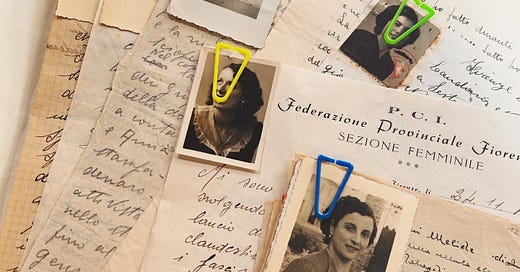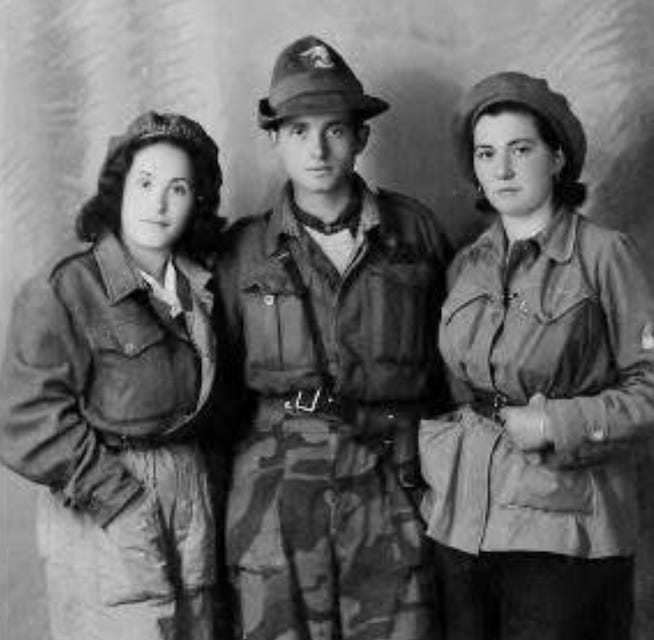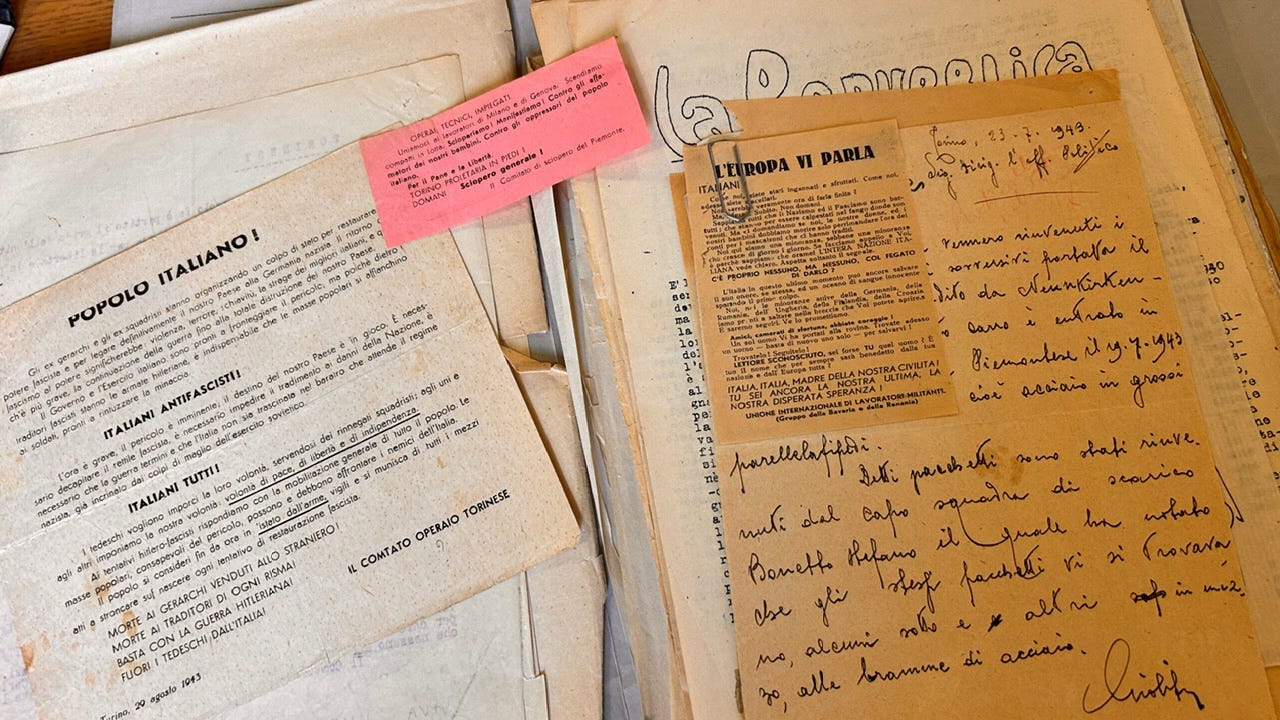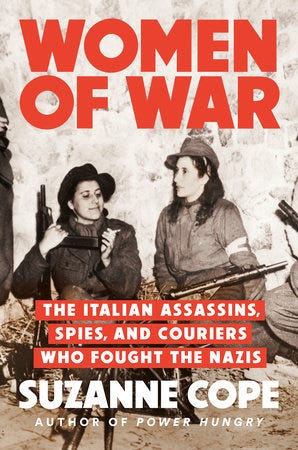Suzanne Cope on WOMEN OF WAR
"Four anti-fascist Italian women who found their agency and became members of the resistance"
Welcome back to SOURCE NOTES. I’m of an age where the word “fascism” was introduced to me via my cassette copy of DIRTY by Sonic Youth. Here we are thirty-three years after DIRTY and “fascism” is suddenly a hot ticket on Google News. But I digress! Go ahead and get yourself a copy of WOMEN OF WAR: The Italian Assassins, Spies, and Couriers Who Fought the Nazis by Suzanne Cope, who joins us now with the story behind the story…
What’s WOMEN OF WAR about?
It’s about four anti-fascist Italian women who found their agency and became members of the resistance: Carla Capponi in Rome, Teresa Mattei from Florence, Anita Malavasi from Reggio Emilia, and Bianca Guidetti Serra from Turin. Each of them had different roles. I chose these four because they showed the breadth of women’s experiences and contributions to the resistance while also telling the larger story of the resistance
A lot of the material you needed was in Italy. How many trips did you take?
I took three trips specifically for the research of this book. On one of those trips, I was there for five weeks as part of a fellowship through NYU’s Global Research Institute. I was based out of NYU’s Florence campus, and I was able to take a bunch of short trips from there, and also have their support helping to connect me to other libraries and archives.
Tell me about some of those.
In the U.S., we often think of archives as being part of a university. In Italy, they have a lot of independent archives. They have archives specifically dedicated to the resistance, to remembering the resistance. A lot of them are regional and they gather stories and documents from World War II. There's an organization in Reggio that was just so helpful and wonderful, and they also had videos of Anita and answered a lot of questions. There’s another archive in a very small town that is inaccessible by public transportation, that really feels like you’re in the middle of nowhere. And they have this national archive diary where they keep written testimonies of all sorts of people. I found testimony of Anita’s there that wasn't available anywhere else. She is probably the least known of the four, so her testimonies were really important because she didn’t leave a lot behind. And then there’s an archive in Torino where some of Bianca’s papers are there. That’s part of Ada Gobetti’s archive. She’s in the book. Her husband was an early anti-fascist, and the actual house where she lived during World War II has been turned into this very cool archive.
I’d imagine these things aren’t necessarily catalogued in the way you’d expect to find them in some university archive in the states.
I so much had to rely on the archivists. They brought out boxes and boxes of stuff that I just had to search through. I mean, it drove my publisher nuts because I didn't really have a strong way of citing these archives. It was just like, here’s a box of stuff. But I found a lot of really amazing material.
Like what?
Bianca and some of the other people who helped organize the strikes, they would hand these little slips of paper out, like tiny, tiny ones, two fingers big, that they would just slip into a pocket. I'm getting chills even just thinking about it.
And you’re sitting there in an archive holding them.
It transports you there. Also in those archives, the partisan band that Bianca’s future husband Alberto was in, there was a notebook that that was just documenting what the band did. So I was able to actually recount like, oh, they attacked a fascist armory on this day and stole some weapons.
One of the archives you visited is actually housed in a former fascist prison.
Via Tasso in Rome. It wasn’t just a police jail that they turned into a fascist jail. It was like, a barracks with offices and then the fascists took it over and turned the offices into jail cells and blocked off the windows. After the war, it was turned into a museum and archive. And it’s really powerful because in some of the jail cells, you could see where people scratched writing on the walls, warning of this or that or saying goodbye to someone. It was very, very moving. And on the main floor, they have archives and a library.
What other places did you visit that helped tell the story?
In Rome, I could literally follow Carla’s steps. The opera where she had done her first action. Looking at the Cinema Barberini and figuring out how she came down the hill and where the hill was in relation to where the waiting vans probably were. With Anita, when she had to leave Reggio to join the partisan bands in the mountains, there were these paths they had walked, and now hikers can take the same steps, so I did a little bit of that hike. I did the same thing with Bianca, seeing some of the places she went in the Alps. I drove these paths, but she rode a bicycle up them and down. Those moments are in the book in such a subtle way, but a really important way.
You were able to talk to at least two living associates of Bianca’s.
Her son and her friend Santina.
How did you track them down?
Santina was her co-writer. I was able to get to her through Bianca’s archive. Santina was so wonderful and answered a lot of follow-up questions. She was younger than Bianca, obviously, but knew her for many years professionally and as a friend.
Is she the one who connected you with Bianca’s son?
Yes, Fabrizio. Anita didn't have children; she never married. Carla married and divorced, and then her child died. And Teresa, the only child of hers I could track down refuses to talk to the press. Fabrizio’s probably in his seventies or eighties. He’s the one who provided a photo of her I had never seen that ended up in the book. He said I actually told him a lot of things he didn’t know about his mom. They didn’t really talk about the resistance very much. They would provide their testimony for official purposes, but it wasn’t something they just sat around and reminisced about.
Going to Italy three times for book research sounds dreamy, but for your next one are you trying to find something closer to home?
You know, my editor suggested that maybe I do an international story every other book. So right now I’m interested in the United States during the 1930s. There are some really interesting stories and parallels we could learn from there. And a lot of those stories are very New York focused. So I guess the next book will likely be very close to home.








